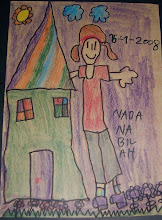
At 8:15 A.M. August 6, 1945, the first atomic bomb ever to be dropped, exploded approximately 580 meters above the center of the city of Hiroshima, Japan.
In less time than it takes to blink your eyes, the city was reduced to rubble in the middle of a scorched plain. Countless unsuspecting and innocent lives were lost.
So enormous was this unprecedented tragedy that the destruction caused by natural disasters or conventional weapons paled beside it.
In less time than it takes to blink your eyes, the city was reduced to rubble in the middle of a scorched plain. Countless unsuspecting and innocent lives were lost.
So enormous was this unprecedented tragedy that the destruction caused by natural disasters or conventional weapons paled beside it.
SADAKO Sasaki was only two years old when the first atomic bomb was dropped on Hiroshima. On that day, she was a mere two kilometers away from where the bomb exploded. Most of Sadako's neighbors died, but Sadako wasn't injured at all, or so it seemed. Up until the time Sadako was in the seventh grade (1955) she appeared to be a normal, happy young girl.
She ran and played with her friends at home and at school. She was a good student who excelled in Track. However, one day after an important relay race that she helped her team win, she felt extremely tired and dizzy. Fortunately, that day, the dizziness went away leaving Sadako to think that it was only the exertion from running the race that made her tired and dizzy. But that was not to be so. Soon after her first encounter with extreme fatigue and dizziness, she experienced more incidents of the same.
One day Sadako became so dizzy that she fell down and couldn’t get up. All of her school-mates informed the teacher who contacted her parents. Later Sadako’s parents took her to the Red Cross Hospital to see what was wrong with her.
Doctors performed many tests and discovered that Sadako had a kind of blood cancer called leukemia. Nobody could believe it. At that time, leukemia was called the “A-bomb disease”. Almost everyone who got this disease died, and Sadako was very scared. She wanted to go back to school, but she had to stay in the hospital.
One day, Sadako's best friend, Chizuko, came to visit her and brought with her some origami (folding paper). She told Sadako the legend of the crane.
It is Japanese legend that folding 1000 cranes (senzaburu) so pleases the gods that the folder is granted a wish. Sadako wished to get well. So, after hearing the legend, Sadako decided to fold 1,000 cranes.
Sadako's family worried about her a lot. They often came to visit her in hospital to talk to her and to help her fold cranes. After she folded 500 cranes she felt better and the doctors said she could go home for a short time, but by the end of the first week back home the dizziness and fatigue returned and she had to return to the hospital.
Sadako continued to fold cranes. Even though she was in great pain, she tried to be cheerful and hopeful. Not long afterwards, with her family standing by her bed, Sadako went to sleep peacefully, never to wake up again. She had folded a total of 644 paper cranes.
Sadako's story had a profound impact on her friends and classmates. They completed her thousand cranes and continued to raise money from school children all over Japan to build a statue to honor Sadako and all the children affected by the bomb.
Today, in Hiroshima's Peace Park, there is a statue of Sadako standing on top of a granite pedestal holding a golden crane in her outstretched arms. At its base a plaque reads:
This is our cry.
This is our prayer.
Peace in the world.
(story taken from http://user1291600.sites.myregisteredsite.com/library/id49.html )

